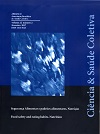0214/2016 - Relationship between risk classifications, used to organizing the search for oral health in small São Paulo City.
Relação entre classificações de risco, utilizadas para organização da demanda em saúde bucal em município de pequeno porte de São Paulo.
Author:
• Peres, João - Peres, João - Faculdade de Odontologia de Piracicaba - <jperesnetocd@yahoo.com.br> +Co-author(s):
• Maria da Luz Rosário Sousa - Sousa, Maria da Luz Rosário - Faculdade de Odontologia de Piracicaba(FOP/UNICAMP) - <luzsousa@fop.unicamp.br>• Karine Laura Cortellazzi - Cortellazzi, K.L. - Universidade Estadual de Campinas - <karinecortellazzi@gmail.com>
ORCID: https://orcid.org/0000-0001-9584-9477
• Ronaldo Wada - Wada, Ronaldo - Faculdade de Odontologia de Piracicaba - <rwada@fop.unicamp.br>
Thematic Area:
Saúde BucalAbstract:
AbstractThe oral health teams can work with both information of the people related to the family context as individual epidemiological through risk ratings considering equity and service organization. The purpose of the study was to evaluate the association between tools that classify individual and family risk. The study group consisted of studentsthe age group of 5-6 years and 11-12 years were classified to decay and their parents to periodontal disease and both for the family risk. There was an association between the risk rating for decay in children (n = 128) and family risk classification with Coef C = 0.338 and p = 0.01, indicating that the higher the family‘s risk higher risk of caries trend. Similarly, the association between the risk classification for periodontal disease in parents, and family risk classification with Coef C = 0.5503 and p = 0.03, indicating that the higher the family risk is no greater risk of disease trend periodontal. It can be concluded that the use of family risk rating tool is indicated as a possibility of ordering the actions of the dental service, organizing their demand with greater equity, this access door.











